SOCR EduMaterials Activities Histogram Graphs
From Socr
Contents |
SOCR Educational Materials - Activities - SOCR Histogram Generation Graphing Activity
Summary
This is an exploratory data analysis SOCR activity that illustrates the generation and interpretation of the histogram of quantitative data. The complete details about histograms can be found here. In a nutshell, a histogram of a dataset is a graphical visualization of tabulated frequencies or counts of data within equispaced partition of the range of the data. A histogram shows what proportion of measurements that fall into each of the categories defined by the partition of the data range space.
Exercises
Exercise 1: Simple Histogram from Raw Data
- This exercise demonstrates the construction of a histogram plot from raw quantitative data.
- First, point your browser to SOCR Charts and select the HistogramChartDemo (under BarCharts --> XYChart). There are three different ways to select data for this histogram chart:
- Use the default data provided for this chart (DEMO button);
- Enter your own data. This can be done by copying to the mouse buffer data from external spreadsheet/table, clicking on the top-left cell in the SOCR Histogram Data table and pasting (Paste button) the data into the histogram data table. Remember to MAP the data - this indicates what columns rows, parts of the data need to be used in teh histogram calculations. Then you click UPDATE chart to have the new graph drawn in the Graph tab-pane;
- Obtain SOCR simulated data from the Data-Generation tab of the SOCR Modeler ( an example is shown here).
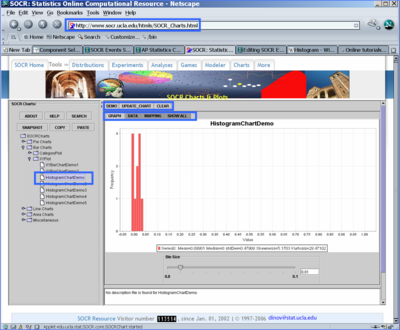
Exercise 4: Power Transformation Family in a Time/Index Plot Setting
- Let’s first get some data: Go to SOCR Modeler and generate 100 Cauchy Distributed variables. Copy these data in your mouse buffer (CNT-C). Of course, you may use your own data throughout. We choose Cauchy data to demonstrate how the Power Transform Family allows us to normalize data that is far from being Normal-like.
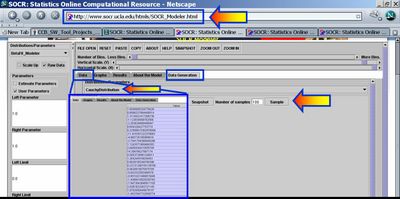
- Next, paste (CNT-V) these 100 observations in SOCR Charts (Line-Charts -> Power Transform Chart). Click Update Chart to see the index plot of this data in RED!
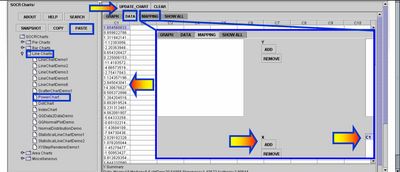
- Now go to the Graph Tab-Pane and choose λ = 0 (the power parameter). Why is λ = 0 the best choice for this data? Try experimenting with different values of λ. Observe the variability in the Graph of the transformed data in Blue (relative to the variability of the native data in Red).
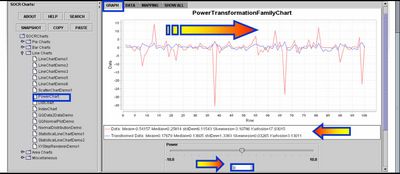
- Then go back to the Data Tab-Pane and copy in your mouse buffer the transformed data. We will compare how well does Normal distribution fit the histograms of the raw data ( Cauchy distribution) and the transformed data. One can experiment with other powers of λ, as well! In the case of λ = 0, the power transform reduces to a log transform, which is generally a good way to make the histogram of a data set well approximated by a Normal Distribution. In our case, the histogram of the original data is close to Cauchy distribution, which is heavy tailed and far from Normal (Recall that the T(df) distribution provides a 1-parameter homotopy between Cauchy and Normal).
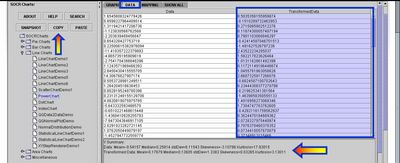
- Now copy in your mouse buffer the transformed data and paste it in the SOCR Modeler. Check the Estimate Parameters check-box on the top-left. This will allow you to fit a Normal curve to the histogram of the (log) Power Family Transformed Data. You see that Normal Distribution is a great fit to the histogram of the transformed Data. Be sure to check the parameters of the Normal Distribution (these are estimated using least squares and reported in the Results Tab-Pane). In this case, these parameters are: Mean = 0.177, Variance = 1.77, however, these will vary, in general.
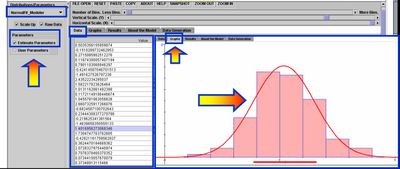
- Questions
- What is the effect of the width/size of the histogram bin on the shape of the resulting histogram? Would the shape of the histogram change significantly if we alter the bin-size? Does the sample-size play role in this?
- Would you expect the shape of the sample histogram to look like the shape of the population distribution the data sample came from?
- SOCR Home page: http://www.socr.ucla.edu
Translate this page:
